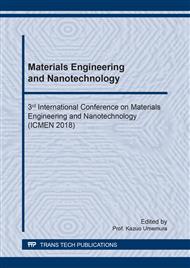p.58
p.63
p.71
p.77
p.82
p.88
p.93
p.98
p.105
Carbon/GO Composite Electrodes and Electrospun Polyacrylonitrile Nanofibrous Electrolyte Membranes Doped with Halogen-Free Imidazole-Based Ionic Liquid for Supercapacitor Device Fabrication
Abstract:
In this paper, we report the preparation of 1-methylimidazolium acetate (MIMOAc) through solvent-free sonochemical synthesis and its characterization using 1H-NMR, 13C-NMR and FTIR-ATR spectroscopy. Its effects on the morphological, structural and electrochemical properties of electrospun polyacrylonitrile (PAN) fibers were also investigated. SEM and AFM results showed that the MIMOAc-doped PAN fibers produced are thinner than that of the pristine PAN hence allowing more surface area for ion mobility. Its electrochemical performance compared well to the obtained results in preference to the conventional 1M KOH(aq) as aqueous electrolyte. The fabrication of a novel supercapacitor prototype following an electrical double-layer capacitor configuration assembled by mechanically pressing the electrospun MIMOAc/PAN nanofiber membranes between two activated carbon/graphene oxide (GO) composite electrodes on ITO-coated glass current collectors was presented in detail.
Info:
Periodical:
Pages:
82-87
Citation:
Online since:
October 2018
Keywords:
Price:
Сopyright:
© 2018 Trans Tech Publications Ltd. All Rights Reserved
Share:
Citation:


